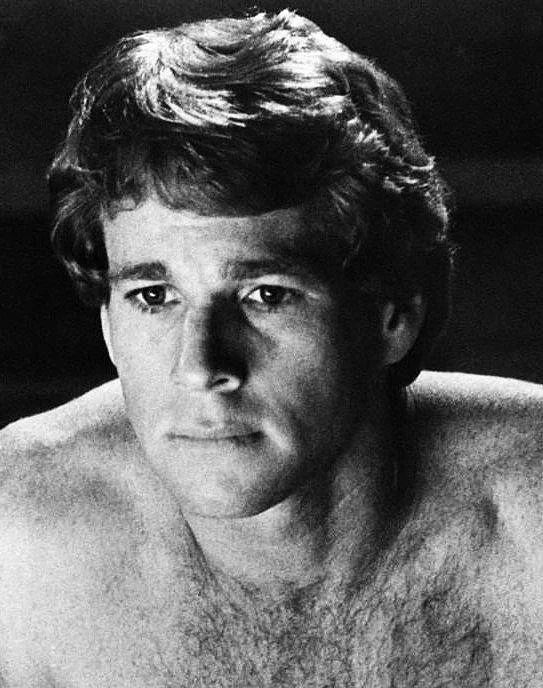RYAN O’NEAL
(20 April 1941 - 8 December 2023)
Ryan O’Neal, who has died aged 82, began his career training to be a boxer. He even attended University High School in Los Angeles hoping to become a Golden Gloves champion. As he was no academic, he found work as a stuntman and thus began a reasonable career as an actor in films. He also appeared on television, although his subsequent career was not always a great success. Ryan O’Neal was born in Los Angeles to the novelist and screenwriter Charles O’Neal and his wife, the actress Patricia O’Callaghan. In the late 1960s, O’Neal Sr moved his family to Munich where he was writing for German TV. Ryan attended the Munich American School but couldn’t keep up, so his parents found him work as an extra and stuntman.
Back in the US, he made his TV debut in the sitcom The Many Loves of Dobie Gillis (1960). From 1962 he was in some 30 episodes of NBC’s modern Western Empire, as well as 24 episodes of the police procedural Bones. In 1964 O’Neal was part of the long-running TV drama Peyton Place, based on the 1957 film with Lana Turner. It ran for over 500 episodes, spawning many future stars such as Mia Farrow, Barbara Parkins, Glynn Turman, Lana Wood and Leigh Taylor-Young. O’Neal then made his first film, The Big Bounce in 1969. Based on a novel by Elmore Leonard it has a young couple, O’Neal and Leigh Taylor-Young, trying to rob a $50,000 payroll account. It was the first Jack Ryan movie and was remade in 2004 with Owen Wilson.
After that came Michael Winner’s The Games with O’Neal as an American Olympic runner but the film never broke even. It was written by Erich Segal who recommended O’Neal for the film of his own best-selling novel, Love Story. Here O’Neal plays Oliver Barrett IV, a rich upper-class Harvard student who meets a working-class girl, Jenny (Ali MacGraw). Of course, they fall in love and marry, against their parents’ wishes. Jenny then contracts something fatal. “Love means never having to say you’re sorry” was the film’s legend, but who would feel sorry considering the movie made a mint? It also garnered seven Oscar nominations, with Francis Lai’s now-iconic score walking away with a statuette.
In 1972 O’Neal teamed up with Barbra Streisand for Peter Bogdanovich’s screwball comedy What’s Up, Doc?, concerning a music professor’s involvement with a crazy lady. O’Neal was the myopic professor, Streisand the kookie broad. They matched perfectly and the film was a massive hit. With Bogdanovich again O’Neal made Paper Moon, playing a conman Bible-seller in 1930s Kansas who meets a young girl at her mother’s funeral. The girl, Addie, was, at Bogdanovich’s suggestion, played by O’Neal’s own daughter Tatum at just eight years old! She then becomes his accomplice and they hit the road, getting in and out of trouble. It’s a great film shot beautifully in monochrome by Laszlo Kovacs. Tatum won an Academy Award as well as a Golden Globe but her father, as good as he was, came away empty-handed.
Stanley Kubrick’s very fine historical drama Barry Lyndon saw Ryan O’Neal cast against type: he was excellent as an 18th-century gambler who, after killing his cousin’s lover, enlists in the British army and enjoys a picaresque journey around Europe. The film won four Oscars but none for acting. Back with Bogdanovich for Nickelodeon, O’Neal played a lawyer-cum-writer and director of silent movies in 1914. This salute to early movies was a delight but did not go down well at the box-office.
O’Neal then joined the all-star cast in Richard Attenborough’s war epic A Bridge Too Far, about Operation Market Garden in Nazi-occupied Holland, which was followed by Walter Hill’s The Driver (1978), a well-made thriller about a man who steals cars for getaway robberies. Oliver’s Story was a sequel to the original Love Story by the same writer but it failed commercially. The Main Event was a better proposition in 1979, a comedy that again teamed O’Neal with Streisand as a failed businesswoman who takes on ex-boxer O’Neal in order to reap a fortune. The pairing worked and, despite poor reviews, it was a commercial hit. It was also the alternate cover for the 1979-1980 Film Review annual. Other films on O’Neal’s roster included Partners, a gay buddy cop comedy with John Hurt, Norman Mailer’s Tough Guys Don’t Dance and a small role in Terrence Malick’s Knight of Cups. His last film was the 2015 documentary Unity.
Ryan O’Neal married the actress Joanna Moore in 1963 and they had Tatum and Griffin, but separated in 1966. He then married Leigh Taylor-Young and had a son, Patrick. They, too, divorced but remained friends. He was in a relationship with the actress Farrah Fawcett and had a son, Redmond, but as O’Neal was often unfaithful and unpredictable in his behaviour, they separated, although they were reunited from 2001 until she died in 2009. He admitted being a bad father to his children who he physically abused because of his drug taking which he passed onto them. O’Neal survived leukemia in 2001 but in 2012 was diagnosed with prostate cancer from which he eventually died.
MICHAEL DARVELL

